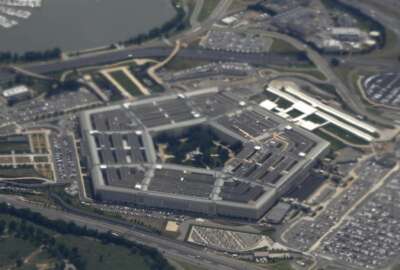
Pentagon preparing sole-source contract to replace Defense Travel System
Following an apparently successful pilot project, DoD plans to start negotiations with SAP Concur on the price tag to fully replace its existing system.
The DoD Reporter’s Notebook is a weekly summary of personnel, acquisition, technology and management stories that may have fallen below your radar during the past week, but are nonetheless important. It’s compiled and published each Monday by Federal News Network DoD reporters Jared Serbu and Scott Maucione.
The Defense Department appears ready to move ahead with a full-scale replacement for the much-maligned Defense Travel System, the aging IT platform DoD personnel currently use to make official travel arrangements.
The Pentagon is about to start negotiations with Concur Technologies on a sole-source contract for the replacement system, called Defense Travel Modernization, according to a notice the department published April 30.
That yet-to-be-determined price tag would go toward fully implementing what began as a “prototype” project in August 2018, when DoD awarded a $9.3 million other transaction agreement to Concur, a subsidiary of the global software giant SAP. Officials said at the time that the firm qualified for an OTA because it met the legal criteria as a “nontraditional” Defense contractor.
The most recent notice and prior documents indicate DoD has spent $15 million to integrate SAP Concur’s commercial travel software with the military’s business processes and IT systems, including the Navy’s enterprise resource planning system and the Army’s General Fund Enterprise Business system.
It added that DoD plans to award the full-scale production contract without competition because Concur, having completed the prototype, is the “only responsible source and no other supplies or services will satisfy agency requirements.”
The notice gives competing vendors until May 17 to argue otherwise – but strongly hints they’re unlikely to make a successful case because of all the work that’s already been conducted during the “prototype” phase. An alternative to the Concur system would, for example, need to integrate with DoD personnel databases, support types of travel that are unique to the military, and have the system certified with a high-level authority to operate (ATO) from the Defense Information Systems Agency.
DoD officials have previously said they expect DTM to dramatically simplify the current system, which relies on complicated interconnections between private travel management companies delivering ticketing services and individual military services’ personnel and finance accounting systems. When the prototype OTA was awarded, the department predicted it would save 10 million labor hours per year, and reduce its travel administration costs “exponentially.”
The extent to which the original prototype award was subject to competition isn’t clear, because DoD handled the procurement through a private consortium, the Consortium for Command, Control and Communications in Cyberspace (C5). In that structure, the government makes the award on the basis of white papers it receives from consortium members, and its solicitation documents and the number of offers it receives are not made public.
The statute that authorizes DoD to use OTAs also gives the department permission to award a follow-on production contract to the same firm that won the prototype contract, as long as “competitive procedures” were used for the prototype. DoD is not leveraging that authority for DTS, and relying instead on the fact that Concur is the only “responsible source” that can meet its needs at this point. —JS
Air Force says it needs to fill top space acquisition role soon
Congress and the Department of the Air Force are concerned that space acquisition isn’t coalescing fast enough after the creation of the Space Force.
One of the main selling points of the new service was that it would be a centralizing agency for the Defense Department’s previously disparate space acquisition organizations.
Rep. Betty McCollum (D-Minn.), chairwoman of the House Appropriations Defense Subcommittee, said last Friday that she was concerned about the continued vacancy of the space acquisition executive position created by Congress in the 2020 National Defense Authorization Act.
Acting Air Force Secretary John Roth, said he, too, was concerned that the position was not filled in the last administration, and continues to lay fallow. However, he said the Department of the Air Force is working on priming the office for the best possible results.
“We haven’t sat on our hands, we’ve taken a look at that office and we’ve organized it in a way that whoever comes in, can hopefully hit the ground running,” he said. “That person will obviously need to influence that where we go forward.”
The position technically does not switch over to the space acquisition executive until October 2022. Until then, it remains a vestige of the Air Force’s space acquisition and integration office.
Roth said the Air Force is considering asking Congress to change the law so that the position must be filled no later than October 2022, to add more urgency to filling the position.
Whoever takes the job would work with the Air Force service acquisition executive on space systems. They would also be in charge of the Space Development Agency, the Space Rapid Capabilities Office and the Space and Missile Systems Center.
“A big part of what we’re doing now is preparing ourselves and posturing ourselves for that new responsibility that will be coming,” Shawn Barnes, who is performing the duties of Air Force assistant secretary for space acquisition and integration said in January. “We’re working very closely with Air Force acquisition to determine what sorts of capability and capacity that this office will need in terms of people, in terms of facilities and networks and clearances and all those kinds of things, so that we can do that service acquisition executive job once that responsibility moves over.”
Since the creation of the Space Force, Roth said service has had some acquisition issues.
“Cost, schedule and performance are the keys to any acquisition program and are a management imperative,” he said. “We’ve had issues on both the air and space side in terms of staying on schedule and performing. It takes attention across the enterprise. Across the Department of the Air Force enterprise, we are taking a new approach, a new modern, more aggressive, more accelerated approach to try to eliminate bureaucracy. We are trying to focus people on goals and coming up with meaningful metrics, and making sure we manage risk in a way that makes some sense. Too often we over promise and underperform, and we need to fix that.”
Roth said Frank Kendall, the nominee as the next Air Force secretary, will bring in much needed acquisition experience. — SM
Marine Corps pushing for more time for new mothers
The Marine Corps is pulling some strings so that new mothers can take up to five months of maternity leave.
The new policy doesn’t explicitly give mothers the whole five months; maternity leave is capped at 12 weeks.
However, the directive from Marine Corps Commandant Gen. David Berger encourages commanders to allow mothers to take sick leave and other forms of leave after their maternity leave is used up.
“Commanders are strongly encouraged to approve annual leave in conjunction with Military Parental Leave Program (MPLP),” the directive states. “Circumstances that may cause leave to be denied include factors associated with the unit’s mission or specific operational requirements. MPLP must be exhausted before annual leave can be used for the purpose of primary caregiving after a birth event or adoption. If a Marine has not accrued 60 days of annual leave, requested advance leave up to 45 days may be authorized if those days can be accrued before the Marine’s end of contract.”
Since taking the top position in July 2019, Berger has championed changes to personnel issues within the Corps. In his first published planning guidance he called for a year of maternity leave for new mothers.
Berger’s planning guidance called out the current manpower model as based on producing mass over quality and stated that the Marines currently look at time and experience, rather than talent, performance or future potential.
“While performance is factored into promotion selection, it is narrowed to a slim cohort, roughly based on year groups — an antiquated model,” the guidance states.
Those policies, he said, separated Marines from the service at critical points.
“Current policies drive increased permanent change of station costs, throw away talent at the point it is most productive and highly trained, and discourage performers who would like to continue serving, but may be less interested in promotion or constant disruptive moves of questionable personal and professional value,” Berger said.
All of the military services have been trying to give new parents a break. In recent years the branches have expanded maternity leave and parental leave to allow service members more time to adjust. — SM
Copyright © 2025 Federal News Network. All rights reserved. This website is not intended for users located within the European Economic Area.
Jared Serbu is deputy editor of Federal News Network and reports on the Defense Department’s contracting, legislative, workforce and IT issues.
Follow @jserbuWFED
Scott Maucione is a defense reporter for Federal News Network and reports on human capital, workforce and the Defense Department at-large.
Follow @smaucioneWFED






